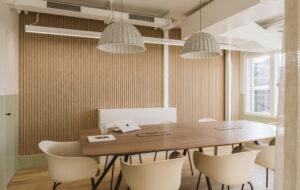 (L-R) Russell Curtis, Tim Riley and Dieter Kleiner|TNG has been designed flexibly so that anything seems possible|Timber and natural light sidestep the usual community building cliches|Enfield Business Centre’s new glazed frontage provides a welcoming face|Enfield’s flexible reception space: “More like a pavilion than a foyer”|Building a sense of ownership: TNG Wells Park Youth Centre|Open Eye Gallery, whose Corian facade is the canvas for changing artwork|The gallery bookshop: an outward-looking design helps to increase footfall|Sinta Tantra’s Together Yet Forever Apart, ‘wall art’ for 2012’s biennial|The Europan-winning housing scheme for Stoke-on-Trent|RCKA’s three-storey extension added to tech company De La Rue’s HQ|The De La Rue building fosters the cross-fertilisation of ideas|Acoustitch, RCKA’s artwork for the Crown Estate’s 11 Waterloo Place||
(L-R) Russell Curtis, Tim Riley and Dieter Kleiner|TNG has been designed flexibly so that anything seems possible|Timber and natural light sidestep the usual community building cliches|Enfield Business Centre’s new glazed frontage provides a welcoming face|Enfield’s flexible reception space: “More like a pavilion than a foyer”|Building a sense of ownership: TNG Wells Park Youth Centre|Open Eye Gallery, whose Corian facade is the canvas for changing artwork|The gallery bookshop: an outward-looking design helps to increase footfall|Sinta Tantra’s Together Yet Forever Apart, ‘wall art’ for 2012’s biennial|The Europan-winning housing scheme for Stoke-on-Trent|RCKA’s three-storey extension added to tech company De La Rue’s HQ|The De La Rue building fosters the cross-fertilisation of ideas|Acoustitch, RCKA’s artwork for the Crown Estate’s 11 Waterloo Place||
From high-tech laboratories to community buildings, this trio creates spaces without a trace of gimmickry, where users feel a sense of ownership: the key to a building’s longevity, they say
Architects occasionally struggle with the idea of community. The vaunted ‘Bilbao effect’, now so diluted as to become meaningless, represents the worst cases where a grand vision is imposed on the ‘community’, which shoulders the financial burden until said arts centre/activity hub/museum limps toward abandonment and closure.
The Public, a government-funded community arts space in West Bromwich designed by Will Alsop, is a classic example. The black box, adorned with a blobby pop art motif, overshot its budget by some way, opened late, and closed last year. The era of icon building, though littered with follies like this, at least propelled architecture back into the public discussion if only by virtue of the stupendous shapes it yielded.
“Architects seem to fall into two camps at the moment,” says Russell Curtis, one third of London-based architects RCKA along with Tim Riley and Dieter Kleiner. “There are those that feel that the world is not quite how they want it so they try and impose something. And there are those that want to try and understand the world and maybe improve it by working with what is there.”
As we sit in the practice’s TNG Wells Park Youth Centre in sunny Lewisham, surrounded by a gaggle of mothers depositing their pushchairs in one of the building’s generous nooks, it is obvious to which camp the young studio belongs. TNG is the practice’s biggest project to date.
Its mix of events spaces, meeting areas, offices, cafeteria, climbing wall and winter garden, housed behind a rugged pre-cast concrete and polycarbonate facade, deftly sidesteps community building clichés. There are, for example, no primary colours screaming ‘fun’, or childlike murals. “It would be like your dad dancing at the disco,” says Curtis. Instead, there is warm timber and an abundance of natural light.
RCKA’s main interest lay in creating a sense of possibility for the varied occupants and, as such, the blank canvas interior has an underlying feeling of optimism rather than austerity.
“There is no ego working here. We want people to take ownership of the infrastructure we have created. The more ownership people take of the space, the more likely they are to use it,” says Riley, RCKA’s housing specialist.
With more than 30 stakeholders involved, the architects must have felt like plate spinners, but there is no doubt that designing in a high degree of flexibility pre-empted any grumbles. The reception area could hold anything from a dance class to a chess tournament.
“If you don’t allow for those conversations it would be a nightmare, and the architecture is much richer for them,” says Kleiner. From our own conversation it soon becomes clear that, to RCKA, architecture should not always be about architects.
The three directors, who met at university, head up a 12-strong studio they founded in 2008. Each brings a particular expertise: Curtis is well-versed in the commercial and R&D sectors having project-managed the groundbreaking Greenwich Peninsula Sainsbury’s at Chetwoods; Riley’s background is in housing, working with Union North on projects for Urban Splash; Kleiner spent time at Sergison Bates and Hudson Architects and specialises in community and public works (TNG is his baby).
Prior to forming RCKA, the three spent a year or so fiddling with house extensions and entering design competitions for other architects, the design equivalent of ghost writing. In retrospect, beginning a practice in what was a gloomy time for the profession seemed almost foolhardy but in reality it proved nothing of the sort, owing to a dose of entrepreneurial chutzpah.
“You can’t just sit back. We know what is important to us and it gives us the tenacity to go out and get work and make projects happen,” says Kleiner. TNG happened, for instance, because the architects worked with Lewisham Council to snag the £3.5m needed from the defunct MyPlace scheme set up by the last Labour government (“a very long and involved process”). While it would be daft to label RCKA as austerity architects, their methods nevertheless seem apposite for the times.
It was a winning design for biennial housing and urban design competition Europan that got things off the ground. Presented with a canalside site in Stoke-on-Trent, the architects triumphed with a nuanced proposal that went well beyond the brief. “While it was predominantly housing, it was the project that brought all our skill sets together. We were challenging each other, which was really useful,” says Riley.
“We know what is important to us and it gives us the tenacity to make projects happen”
“We looked at regenerating the broader area.” This meant finding ways to revamp the canal network, sourcing biomass CHP from a local exporter and unlocking funding streams for growing grass by local farmers to fuel it. The Commission for Architecture and the Built Environment (CABE) described the project as exemplar.
The scheme helped the practice define itself as a curious blend of architect, consultant and social entrepreneur. This multifaceted response has carried through to later work. RCKA is unusual in that it looks to a wider social or economic context to inform its work. The ideas that made the Stoke-on-Trent design stand out, for example, had little to do with architecture.
Similarly, the success of Liverpool’s Open Eye Gallery hinged on Arts Council funding, which in 2011 was being choked by the coalition government. Footfall was the yardstick that measured whether projects were deemed worthy. An earlier proposal by another architect had involved building a standard white cube, which jarred with the trapezoidal site. “It was quite inward-looking,” says Kleiner.
“If you were going to increase footfall you needed to increase the accessibility.” RCKA split the gallery in three parts adding a shop
that protruded into a covered public space. The jagged Corian wall became a canvas for artwork (a “fourth gallery” is how the architects describe it) enticing passersby to explore the building further and, crucially, spend some money.
When called upon, RCKA is capable of delivering purely commercial buildings, as with its classically modernist office block for technology company De La Rue in the Hampshire countryside. The project draws on Curtis’ expertise in the research and design field, but has parallels with the social spirit of TNG.
Working with workplace specialists David Leon, RCKA refurbished the original offices and added a substantial three-storey extension. Curtis and his team sought to foster more interaction between the lab coats by placing the write-up area on the top floor.
“You have a series of very functional specific areas within a lab because there is only one thing you can do in there.
But actually the innovation and creativity happens when scientists from different disciplines are meeting one another rather than squirrelled away in some little office room.”
The building’s pure white render, undeniably striking against the verdant backdrop, is unlike anything else in their portfolio. If one attached balconies to the generous recessed windows it could almost pass as international-style seaside apartments.
The latest addition to the growing body of work is another workplace – this time a vaguely philanthropic refurbishment of Enfield Business Centre.
To describe the existing structure as tired would be fair, but how to revive it was a question the centre itself seemed unable to answer. As before, the architects tuned their ear to the confused noises the client emitted about rentable space and connecting local businesses and transformed the building from what was effectively a serviced office into a welcoming hub.
Working within another tight budget, RCKA greatly improved the building’s street presence with a glazed frontage embellished with an anodised aluminium arch motif pinched from the neighbouring 1970s buildings. In the best traditions of modern workplace design, the reception is a flexible space for casual meetings and talks. The glass entrance means any activities are clearly visible from the street, adding energy to the building. “It’s more like a pavilion than a foyer,” says Kleiner. A barrel-vaulted ceiling continues the rhythm of the external arches while a Moroccan-style decorative tile lays underfoot.
The hope is that projects like these, funded by the Outer London Fund, will nurture latent business talent in the area and eventually bring about an organic regeneration. Arguably the benefits of architecture are felt most keenly at this grassroots level, however, they are not great money-spinners. While Kleiner agrees with that assessment, he prefers to view it as part of a longer-term plan that will generate more work. RCKA is nothing if not patient.
Nevertheless, the interrogative genesis of Enfield illustrates the directors’ working methods. “We talk about design through dialogue in the office a lot. There is a lot of discussion and a lot of testing and people have to stand by their work and tells us why,” says Riley.
The directors take a dim view of those falling back on BIM software like Revit for easy answers. A recent NLA exhibition on the endless phalanxes of glass towers summed up RCKA’s criticisms of modern computer-driven architecture.
“We refuse to let the technology dictate the design because there are so many schemes where you can tell that it is a Revit-designed building or a SketchUp-designed building,” says Curtis. “There were a lot of SketchUp towers there. Fundamentally, towers may be part of solving a housing problem, but the issue is there are a lot of poorly designed ones going up. The measure of a success of a tower is not how it looks from Parliament Hill but how it interacts with its neighbourhood.”
“The more ownership people take of the space, the more likely they are to use it”
Parametric software is singled out for particular criticism. “The language used is all about taking the architect and putting them on a pedestal because it is so hard for lay people to understand,” says Riley. “So all you are doing is distancing yourself from the
beneficiaries of your work.”
Though the practice is experimenting with BIM for curved and grid shell structures, certain members of the team are barred from using it (“we don’t want them to be encumbered by it”). The motivation to remain engaged with the critical nature of the design process is understandable, but one feels such hardline scepticism represents a missed opportunity.
In responsible hands, and RCKA are certainly that, parametrics could open up possibilities in terms of building efficiency, sustainability and yes, even form. Indeed, if there is one criticism you could level at the practice is that its visuals have not always matched its design chops. This may seem minor quibble especially when you consider the amount of architectural renders that end up as little more than a PR exercise or blog fodder, but image becomes pivotal as projects get larger.
“We are very conscious that we need to do more of that. We have different audiences and we are not always in the room discussing it. They have to show [the design] to someone else,” says Kleiner.
This is the case with one current project, housing and community facilities on the site of the Highgate Newtown Community Centre in Camden. Financially, the project depends on the residential element to fund the public buildings. The trick is finding the balance between the two. Already, the process has become highly politicised, much more so than in a more deprived borough. Educated people with time on their hands can be as big an obstacle as any reactionary planning department so RCKA’s conciliatory and consultative approach is sure to be vigorously tested.
“These things will all make the project better. Buildings are judged on how they perform and how people use them, not on how many awards they win,” says Curtis. “This project will be assessed on how well it serves the community.”
























